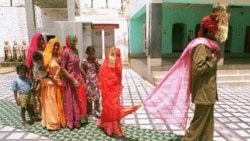International conventions prohibit child marriage and define eighteen as the age of adulthood because children and adolescents are not mature enough to make choices about marriage. In fact, child marriage is a human rights violation, and one that disproportionately affects poor girls. Yet every year, an estimated 14 million girls aged under 18 are married worldwide with little or no say in the matter.
Early marriage harms both the girls and their children. Adolescent girls, and others as young as 8, are a long way from being ready to become wives and mothers. Girls who marry early often quit school. Too frequently, they become pregnant before their bodies are fully developed, and thus they run a high risk of dying as a direct result of pregnancy or childbirth. Worldwide, girls aged 15–19 account for 70,000 such deaths each year.
In developing countries, the infants of mothers under the age of 18 have a 60 percent higher risk of dying in their first year of life than do infants born to mothers older than 19. Such children are more likely to suffer from low birth weight, under nutrition and late physical and cognitive development. They are also less likely to go to school, and to achieve higher levels of education.
And because child marriage stunts girls' educational opportunities and income-earning prospects, it perpetuates poverty in their communities. Thus, because delaying the age of marriage not only benefits the girls themselves, but their families and communities. The United States, through the U.S. Agency for International Development, or USAID, committed an additional $4.8 million to fund programs in Bangladesh, Burkina Faso, Ethiopia, India, Nepal, Tanzania, and Yemen to end child, early, and forced marriage.
These programs, which will focus on education, advocacy for child marriage legislation and enforcement, and economic incentives, are yet another facet of U.S. support for the advancement of women and girls.
“Ending child marriage will not only remove a major barrier to global progress, but also help ensure a world where girls can look forward to growing up,” said USAID Administrator Rajiv Shah. “Together, we can build a future in which all children have the opportunity to reach their full potential.”

















